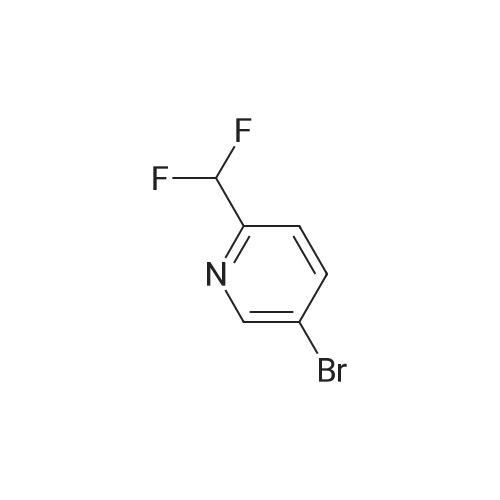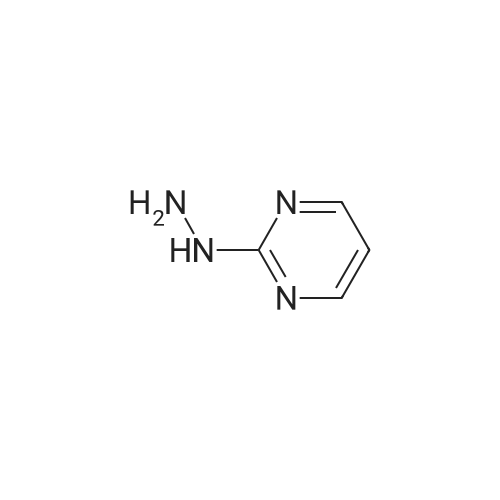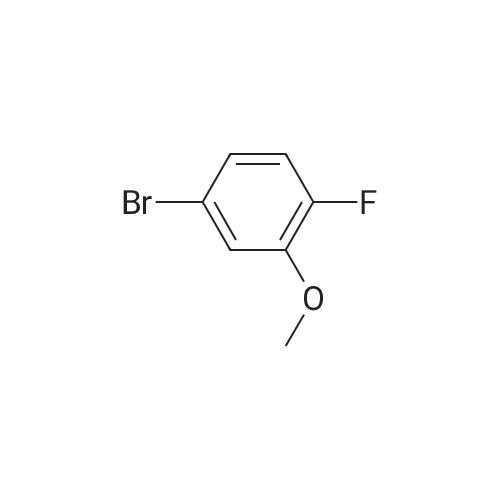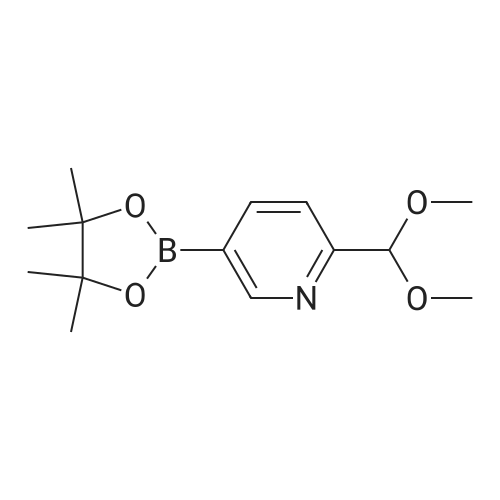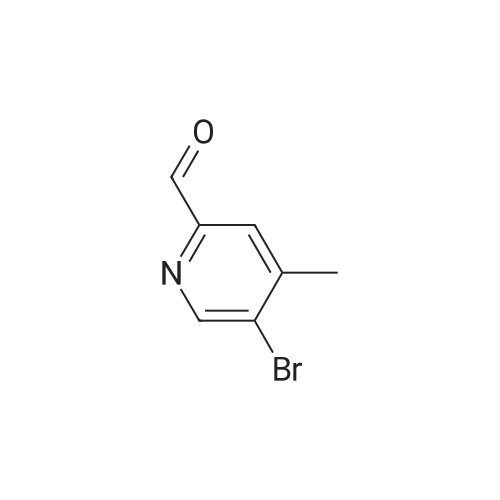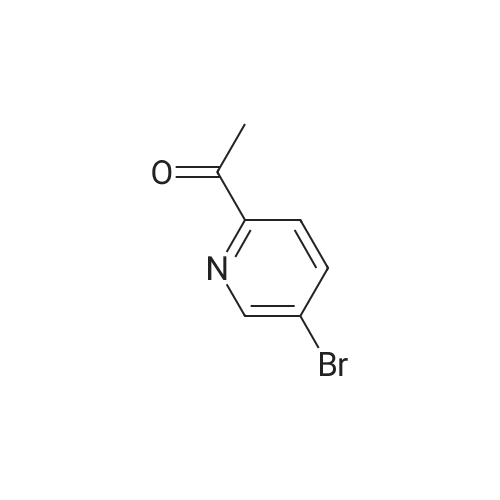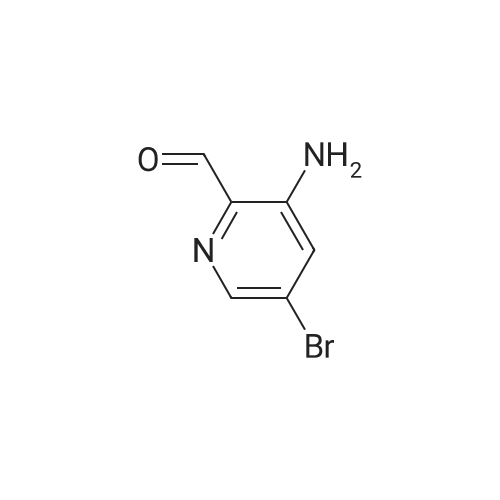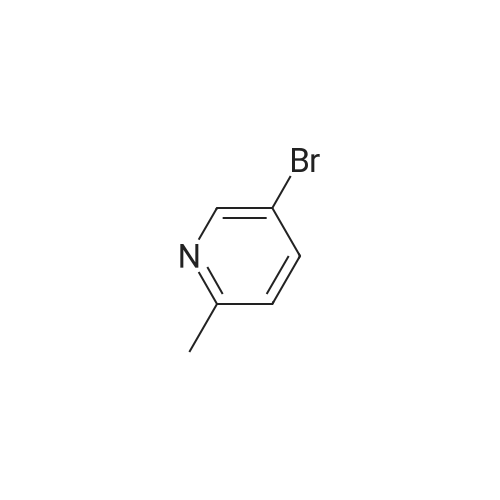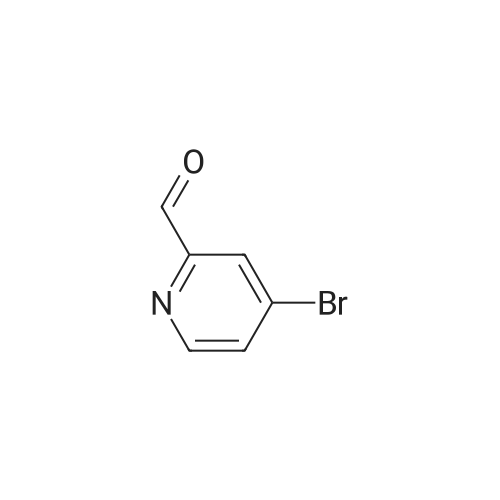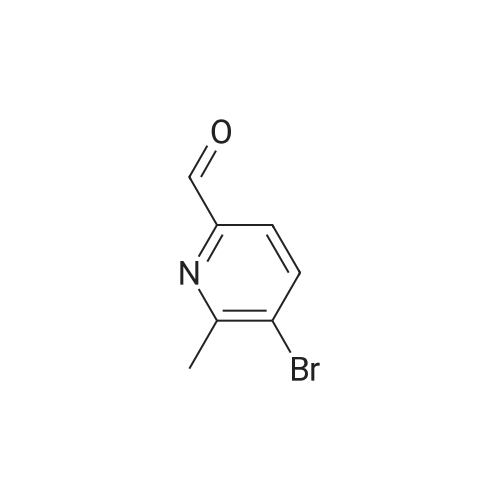| 67% |
With diethylamino-sulfur trifluoride; In dichloromethane; at -78 - 20℃; for 6h; |
To a cooled solution of 5-bromopyridine-2-carbaldehyde (A) (7.0 g, 38 mmol) in CH2Cl2 (300 mL) at -78 C. was added diethylaminosulfur trifluoride (DAST, 10.8 mL, 83 mmol). The reaction was allowed to warm to room temperature over the course of 6 h, then it was quenched slowly with H2O, washed with saturated aqueous NaHCO3 and dried over Na2SO4. Concentration and purification by silica gel plug (CH2Cl2 eluent) furnished 5-bromo-2-difluoromethylpyridine (B) as brown crystals (5.3 g, 67 percent). 1H NMR (300 MHz, CDCl3) delta 8.8 (s, 1H), 8.0 (d, 1H), 7.6 (d, 1H), 6.6 (t, 1H). |
| 67% |
|
To a cooled solution of 5-bromopyridine-2-carbaldehyde (A) (7.0 g, 38 mmol) in CH2Cl2 (300 mL) at -78 C. was added diethylaminosulfur trifluoride (DAST, 10.8 mL, 83 mmol). The reaction was allowed to warm to room temperature over the course of 6 h, then it was quenched slowly with H2O, washed with saturated aqueous NaHCO3 and dried over Na2SO4. Concentration and purification by silica gel plug (CH2Cl2 eluent) furnished 5-bromo-2-difluoromethylpyridine (B) as brown crystals (5.3 g, 67%). 1H NMR (300 MHz, CDCl3) delta 8.8 (s, 1H), 8.0 (d, 1H), 7.6 (d, 1H), 6.6 (t, 1H). |
| 63% |
With diethylamino-sulfur trifluoride; In dichloromethane; at -78 - 20℃; for 6h; |
To a cooled solution of 5-bromopyridine-2-carbaldehyde (A) (7.0 g, 38 mmol) in CH2Cl2 (300 mL) at -78 C. was added diethylaminosulfur trifluoride (DAST, 10.8 mL, 83 mmol). The reaction was allowed to warm to room temperature over the course of 6 h, then it was quenched slowly with H2O, washed with saturated aqueous NaHCO3 and dried over Na2SO4. Concentration and purification by silica gel plug (CH2Cl2 eluent) furnished 5-bromo-2-difluoromethylpyridine (B) as brown crystals (5.3 g, 67%). 1H NMR (300 MHz, CDCl3) delta 8.8 (s, 1H), 8.0 (d, 1H), 7.6 (d, 1H), 6.6 (t, 1H). |
| 54% |
With diethylamino-sulfur trifluoride; In dichloromethane; at 0 - 20℃; for 12h; |
Into a 2000-mL 4-necked round-bottom flask, was placed a solution of 5-bromopyridine-2- carbaldehyde (30 g, 161 .29 mmol, 1.00 equiv) in dichloromethane (800 mL). This was followed by the addition of DAST (diethylaminosulfur trifluoride) (40 g, 1 .08 mol, 6.69 equiv) dropwise with stirring at 0C. The resulting solution was stirred for 12 hours at room temperature. The reaction was then quenched by the addition of water. The pH value of the solution wasadjusted to 8 with sodium carbonate (2 mol/L). The resulting solution was extracted with 3x500 mL of dichloromethane and the organic layers were combined. The resulting mixture was washed with 1x300 mL of H20. The resulting mixture was washed with 1x300 mL of brine. The mixture was dried over anhydrous sodium sulfate and concentrated under vacuum. The residue was applied onto a silica gel column with ethyl acetate/petroleum ether (1:10). Thisresulted in 18 g (54%) of 5-bromo-2-(difluoromethyl)pyridine as yellow oil. |
| 54% |
With diethylamino-sulfur trifluoride; In dichloromethane; at -78 - 20℃; for 5h; |
A stirred solution of 5-bromo-2-picolinaldehyde (10 g, 54 mmol) (Org. Lett. 2004, 6,4905) in dry CH2Cl2 (100 mL) at -78 0C was treated with DAST (9.2 g, 70 mmol) and the resulting reaction mixture was allowed to warm to room temperature over a period 5h. After completion of the reaction, the reaction mixture was quenched by ice-cold water and extracted with CH2Cl2. The organic layer was dried over anhydrous Na2SO4 and the solvents were evaporated in vacuo. The residue was purified by column chromatography (SiO2, 5% Et2O/pet. ether) to afford the title compound (6 g, 54% yield). MS: 210 [M+l]+; 1H-NMR (300 MHz, CDCl3): delta 8.72 (s, IH), 7.93 (d, IH, J= 8.3Hz), 7.54 (d, IH, J= 8.3Hz), 6.60 (t, IH, J= 55.1Hz). |
| 54% |
With diethylamino-sulfur trifluoride; In dichloromethane; at 0 - 20℃; for 12h; |
Into a 2000-mL 4-necked round-bottom flask, was placed a solution of 5-bromopyridine-2- carbaldehyde (30 g, 161.29 mmol, 1.00 equiv) in dichloromethane (800 mL). This was followed by the addition of DAST (diethylaminosulfur trifluoride) (40 g, 1.08 mol, 6.69 equiv) dropwise with stirring at 0C. The resulting solution was stirred for 12 hours at room temperature. The reaction was then quenched by the addition of water. The pH value of the solution was adjusted to 8 with sodium carbonate (2 mol/L). The resulting solution was extracted with 3x500 ml. of dichloromethane and the organic layers were combined. The resulting mixture was washed with 1x300 ml. of water. The resulting mixture was washed with 1x300 ml. of brine. The mixture was dried over anhydrous sodium sulfate and concentrated under vacuum. The residue was applied onto a silica gel column with ethyl acetate/petroleum ether (1 :10). This resulted in 18 g (54%) of 5-bromo-2-(difluoromethyl)pyridine as yellow oil. |
| 36% |
With (bis-(2-methoxyethyl)amino)sulfur trufluoride; In ethanol; dichloromethane; at 0 - 23℃; for 18h; |
Example 32 Preparation of 5-bromo-2-(difluoromethyl)pyridine Deoxofluor (1.7 mL, 9.1 mmol, 1.7 equiv) and ethanol (63 muL, 1.1 mmol, 0.20 equiv) were sequentially added to a stirred solution of 5-bromopicolinaldehyde (1.0 g, 5.4 mmol, 1.0 equiv) in dichloromethane (5.4 mL) at 0 C. The resulting orange solution was allowed to slowly warm to 23 C. and stirred for 18 h. The dark brown reaction mixture was quenched with saturated sodium bicarbonate solution (6 mL) and stirred at 23 C. for 1 h. The reaction mixture was diluted with water (100 mL) and extracted with dichloromethane (3*50 mL). The combined organic layers were washed with 0.1M HCl (1*150 mL), dried (MgSO4), gravity filtered, and concentrated by rotary evaporation to afford the title compound as a brown semisolid (400 mg, 36%): IR (thin film) 3051 (m), 2925 (s), 2853 (m), 1641 (w) cm-1; 1H NMR (300 MHz, CDCl3) delta 8.72 (d, J=2 Hz, 1H), 7.98 (dd, J=8, 2 Hz, 1H), 7.55 (d, J=8 Hz, 1H), 6.61 (t, J=55 Hz, 1H). |
|
With diethylamino-sulfur trifluoride; In chloroform; at 0 - 20℃; |
A solution of 5-bromo-pyridine-2-carbaldehyde (1.0 mmol) in dry chloroform (5 mL) is cooled to 00C and N,Lambda/-diethylaminosulfur trifluoride (2.0 mmol) is slowly added under vigorous stirring. The reaction mixture is reacted 5 minutes at 00C and is then allowed to reach room temperature and is further stirred at this temperature overnight. The reaction is diluted by the addition of chloroform (15 mL), an aqueous saturated sodium carbonate solution (10 mL) is added drop wise and the resulting mixture is stirred for 10 minutes. The organic phase is collected and washed with water (10 mL), brine (10 mL), is dried over magnesium sulphate, filtered and concentrated under reduced pressure to afford the desired product which is used in the next step without further purification. |
| 1.06 g |
|
1 g 5-Bromo-pyridine-2-carboxaldehyde was dissolved in 50 mL DCM. The solution was cooled to -70C, then 1.55 mL diethylaminosulfurtrifluoride was added dropwise over 20 minutes. The suspension was stirred for 30 minutes at room temperature, then 10 mL water was added at 0C followed by slow addition of 20 mL saturated NaHC03 (gas formation). The phases were separated and 2 mL of 4N HC1 in dioxane is added to the organic phase which was concentrated in vacuo to provide 1.06 g product as yellow solid. HPLC-MS: Rt = 0.72 min (method X001 004), M+H =208 / 210. |
| 1.06 g |
With hydrogenchloride; diethylamino-sulfur trifluoride; In dichloromethane; at -70 - 20℃; for 0.833333h; |
5-Bromo-2-(difluoromethyl)pyridine for Example 120 1 g 5-Bromo-pyridine-2-carboxaldehyde was dissolved in 50 mL DCM. The solution was cooled to -70 C., then 1.55 mL diethylaminosulfurtrifluoride was added dropwise over 20 minutes. The suspension was stirred for 30 minutes at room temperature, then 10 mL water was added at 0 C. followed by slow addition of 20 mL saturated NaHCO3 (gas formation). The phases were separated and 2 mL of 4N HCl in dioxane is added to the organic phase which was concentrated in vacuo to provide 1.06 g product as yellow solid. HPLC-MS: Rt=0.72 min (method X001-004), M+H=208/210. |
| 1.06 g |
With diethylamino-sulfur trifluoride; In dichloromethane; at -70 - 20℃; for 0.833333h; |
Synthesis of 5-Bromo-2-(difluoromethyl)pyridine 3.3A solution of 1 g of 5-bromopyridine-2-carbaldehyde in 50 mL DCM was cooled to -70C, then 1 .55 mL diethylaminosulfurtrifluoride were added dropwise over 20 minutes. The suspension was stirred for 30 minutes at room temperature, then 10 mL water were added at 0C followed by slow addition of 20 mL saturated NaHC03 (gas formation). The phases were separated and 2 mL of 4M HCI in dioxane were added to the organic phase which was concentrated in vacuo to provide 1.06 g product as yellow solid. Analysis: HPLC-MS: Rt = 0.72 min (method D), M+H =208 / 210. |

 Chemistry
Chemistry
 Pharmaceutical Intermediates
Pharmaceutical Intermediates
 Inhibitors/Agonists
Inhibitors/Agonists
 Material Science
Material Science













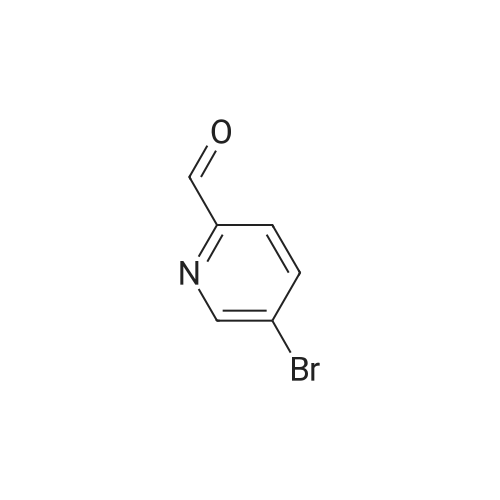

 For Research Only
For Research Only
 120K+ Compounds
120K+ Compounds
 Competitive Price
Competitive Price
 1-2 Day Shipping
1-2 Day Shipping


hydantoins as Glycogen Synthase Kinase-3β Inhibitors.png)



